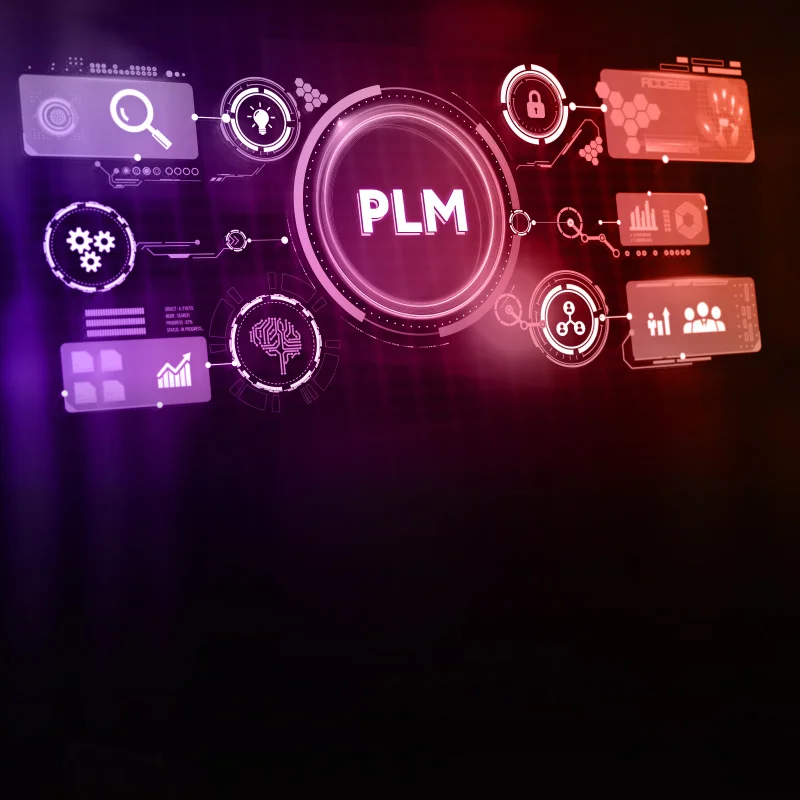Strategies and solutions to transform your engineering workflows with PLM-ERP integration, cloud migration, CAD customizations, and proactive compliance management.
With the shift towards digital engineering, the maturity of the PLM and ALM environments sets the stage for the success of engineering and other downstream functions in manufacturing, automotive, and high-tech industries. Birlasoft’s engineering excellence services help you transform your engineering function into a mature, well-oiled innovation machine that helps you drive success efficiently, from design to production and deployment. Our engineering excellence services span digital and physical products and cover all levels of digital engineering maturity.
Overview
Standardizing workflows, making disparate tool sets work together, and ensuring compliance early on in the product life cycle can greatly reduce time to market, improve quality, accelerate innovation, and unlock new efficiencies. This makes engineering excellence a strategic priority across all manufacturing sectors, from electronics and automotive to high-tech.
However, achieving engineering excellence is easier said than done, especially with the convergence of PLM and ALM. Integrating these environments proves challenging due to disparate toolsets, varying data formats, and nonstandard workflows. Moreover, mitigating security concerns and ensuring compliance with industry standards from the first stage of the product life cycle proves difficult in legacy environments. Modernizing PLM and ALM platforms, and migrating them to the cloud, is therefore a key lever to advance engineering maturity in the industry.
Birlasoft helps manufacturing organizations overcome these challenges by enabling them to achieve engineering excellence. We offer end-to-end engineering transformation services, from consulting and implementation to analytics and monitoring, and we differentiate your engineering transformation with key accelerators to speed your journey.
Our engineering excellence services span:
- Global application managed services (Smart AMS)
- PLM, ALM, and CAD consulting
- PLM-ALM, CAD-PLM, PLM-CRM-ERP integration
- Analytics and reporting for engineering KPIs
- Security and compliance management
- Consolidation and cloud migration
- Configuration, upgrades, and customizations
- Global application managed services

We bring proven frameworks and tools to supercharge your engineering transformation with our ePLM accelerators like
Legend 10TM, iLinkTM, Technotes, and Impacta.
Legend 10TM, iLinkTM, Technotes, and Impacta.
Value Proposition
300+
PLM and ALM consultants
180+
Global clients
Cost savings of over $1m
over 5 years with accelerators like iLink
Domain expertise in
Manufacturing, High-tech, Communications, Media and Entertainment, Industrial, and Automotive
Extensive partner network
PTC, Siemens, Dassault Systemes, IMB, AWS, INTLAND, Microsoft, and Oracle
Cost-effective delivery and round-the-clock support
Without compromising service quality
Solution Features & Benefits
PLM maturity assessment, PLM-ERP integration, cloud migration, and proactive compliance management services to advance digital engineering maturity.
Description
Integrated metrics and statistics to evaluate the current maturity of PLM applications and assess the feasibility of implementing PLM in the cloud through a graded project estimation mechanism. IMPACTA is compatible with all Oracle Agile instances.
Challenges
- Lack of a framework to assess PLM maturity when transitioning to cloud-based PLM.
- Inability to capture intricate PLM data structures, configurations, subclass entities, and integrations.
- Difficulty analyzing user activity and historical usage for a thorough PLM assessment.
Key Features
- Instance profiling and data assessment, with comprehensive insight into PLM data structures.
- In-depth analysis of PLM configurations, subclasses, and object entities with advanced analytics.
- Thorough analysis of process extensions, customizations, integrations, user activity, and historical usage.
- Quick deployment with zero impact on client instance space.
Key Benefits
- Up to 80% reduction in effort required for PLM assessment before cloud migration.
- Detailed assessment data facilitates efficient planning and project sizing.
- Automated capture of assessment data reduces assessment cycle time by 70-80%.
- Proactive mitigation of project risks through extensive data and configuration discovery.
- Minimal prerequisites, zero risk, and no impact on existing deployment and workflows.
Description
Legen 10 facilitates rapid migration of your PLM environment to cloud environments while ensuring complete integrity and reliability. LEGEND 10TM, augmented by our Path-to-Cloud tool, serves as a unified platform for the efficient extraction and migration of data and configurations from on-premises PLM systems to cloud environments. LEGEND 10TM is compatible with all Oracle Agile instances.
Challenges
- Complexity involved in moving data from on-premises to cloud without interrupting existing workflows.
- Handling various data formats and prioritizing migration tasks efficiently in large-scale deployments.
Key Features
- Monitor data flow progress in real-time with a reconciliation framework using LEGEND 10TM Smart Dashboards.
- Automated template generation to ensure data compatibility with Oracle cloud formats.
- Easily handle large-scale PLM migrations and facilitate quick deployment without impacting the existing instance space.
Key Benefits
- Up to 30% reduction in data extraction and migration efforts.
- Available as an end-to-end service encompassing data extraction and migration.
- Pre-configured and thoroughly tested solution helps you reduce migration risk.
Description
iLink PLM Adaptor seamlessly connects leading PLM applications to ERP systems such as JDE, SAP, and EBS.
Challenges
- Integrating PLM and ERP systems proves highly complex due to disparate data formats, toolsets, and workflows.
- Lack of PLM-ERP integration results in operational difficulties, project delays, unforeseen costs, and downstream inefficiencies.
Key Features
- Establish a robust integration between nearly any PLM applications and popular ERP systems.
- Support for multi-branch plants, organization inventory, and plant propagation.
- Adapts to diverse sizes of businesses, various operating models, and different organization structures.
- Incorporates a resilient email notification system to tackle synchronization errors effectively.
Key Benefits
- Easy installation, user-friendly interface, and hassle-free maintenance.
- Requires no additional hardware or middleware for implementing the integration.
- Eliminates uncertainties surrounding cost, project delivery, and operational efficiency.
- Increases productivity by serving as a bridge between innovation and operational efficiency.
Description
Cloud-based user-friendly solution to effortlessly monitor material compliance and Material Data Sheets (MDS) in alignment with key standards like RoHS, REACH, Conflict Minerals, and WEEE.
Challenges
- Ensuring compliance with multifaceted and constantly evolving environmental regulations during product development.
- Manual data collection, reporting, and material compliance management introduce complexity and inefficiency to the product life cycle.
Key Features
- Our platform provides a simple interface to monitor material compliance against a spectrum of updated standards in real-time.
- Powerful automation capabilities to integrate data collection, reporting, and material compliance management into your existing PLM solution.
Key Benefits
- Easily track and conform to environmental regulations.
- Fostering environmentally responsible practices.
- Ensure compliance without impeding operational efficiency.
- Reduce the burden of data management in compliance.
FAQs
Engineering excellence is the consistent application of best practices, innovative solutions, and high standards throughout all phases of engineering work. It emphasizes quality, efficiency, precision, continuous learning, and a commitment to delivering superior value. It also involves a strong focus on customer satisfaction, safety, sustainability, and ethical practices.
Birlasoft offers key solutions for engineering excellence:
- iLink: Integrates PLM with ERP for seamless data flow.
- CADi: Integrates Solid Edge CAD with PLM for efficient design management.
- Impacta: Analyzes legacy PLM configurations for optimization.
- Legend Migration Framework: Provides a structured approach to PLM migrations.
- GPR: Manages global product registration for regulatory compliance.
- UDI: Ensures compliance with unique device identification requirements for medical devices.
Achieving engineering excellence involves creating a culture of continuous improvement, investing in the right tools and technologies, prioritizing training and development, fostering collaboration across teams, and setting clear, measurable goals. It also requires embracing innovation, maintaining high-quality standards, and regularly evaluating and refining processes.
Some best practices include: -
- Establishing clear requirements and specifications.
- Adopting agile or lean methodologies for continuous iteration and feedback.
- Implementing rigorous testing and validation at each stage of the engineering process.
- Fostering cross-functional collaboration between engineers, designers, and stakeholders.
- Maintaining comprehensive documentation to track decisions and improvements.
Engineering excellence directly impacts business performance by improving product quality, reducing errors and rework, increasing operational efficiency, and enhancing customer satisfaction. This, in turn, leads to higher customer loyalty, better brand reputation, and a competitive edge in the market.
Innovation drives engineering excellence by introducing new ideas, solutions, and technologies that can significantly improve processes, reduce costs, and deliver enhanced functionality. It encourages creative problem-solving and pushes the boundaries of what's possible, leading to breakthrough products and services.
Key skills include: -
- Technical expertise in relevant fields of engineering.
- Problem-solving and critical thinking.
- Project management and the ability to deliver on time and within budget.
- Collaboration and teamwork, working effectively with cross-functional teams.
- Adaptability to new tools, technologies, and processes.
- Communication skills to convey complex technical information to diverse stakeholders.
Common metrics include: -
- Product quality metrics, like defect rates and customer satisfaction scores.
- Efficiency metrics, such as time-to-market or production efficiency.
- Innovation metrics, like the number of patents or new product features.
- Employee satisfaction and retention rates to assess team health.
- Cost management, including project cost variance and return on investment (ROI)
Trends include: -
- Automation and AI for streamlining repetitive tasks and improving decision-making.
- Sustainability-focused engineering, incorporating green design and eco-friendly materials.
- Digital twins and simulation to test designs virtually before implementation.
- Agile engineering practices for faster, more flexible product development.
- Collaborative engineering tools that enable distributed teams to work more efficiently.
Engineering excellence and sustainability are closely linked, as sustainable practices often lead to more efficient, cost-effective, and resource-conscious solutions. By designing with sustainability in mind, engineers can create longer-lasting products, reduce waste, and decrease the environmental impact of manufacturing processes.
Engineering excellence in PLM and ALM refers to the application of best practices, tools, and methodologies that ensure the efficient and effective management of the product or application lifecycle. It involves optimizing processes, ensuring high-quality product development, fostering innovation, and enabling collaboration between engineering teams, all while maintaining consistency and traceability from design to end-of-life.
Engineering excellence in PLM and ALM is crucial because it helps streamline product development, reduces time-to-market, ensures product quality, and minimizes errors. It fosters better decision-making through improved data management, real-time collaboration, and visibility across the lifecycle. This ultimately drives cost-efficiency, increases innovation, and supports regulatory compliance throughout the product or application lifecycle.
PLM (Product Lifecycle Management) focuses on the end-to-end management of a product’s lifecycle from design, development, and manufacturing to disposal, with an emphasis on collaboration, data management, and process control. ALM (Application Lifecycle Management), on the other hand, refers to the management of the lifecycle of software applications, covering stages like development, testing, deployment, and maintenance. While PLM is product-focused, ALM is primarily concerned with software applications.
The key benefits of PLM and ALM solutions include:
- Increased Efficiency: Streamlining processes to reduce redundant tasks and manual errors.
- Improved Collaboration: Cross-functional teams can collaborate seamlessly, ensuring faster decision-making and innovation.
- Enhanced Product Quality: With better tracking, design iteration, and quality control, the final product or software is more reliable and meets customer expectations.
- Reduced Time-to-Market: Faster development cycles by eliminating bottlenecks and improving workflow management.
- Better Compliance and Risk Management: Ensuring products meet regulatory requirements and reducing the risks associated with product defects or software failures.
Partnerships & Collaboration







Ready to transform your engineering function with digital?
Birlasoft experts are ready to bring engineering excellence to your organization.



